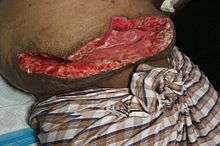Wound dehiscence

Wound dehiscence is a surgical complication in which a wound ruptures along a surgical incision. Risk factors include age, collagen disorder such as Ehlers-Danlos Syndrome, diabetes, obesity, poor knotting or grabbing of stitches, and trauma to the wound after surgery.[1]
Symptoms
Symptoms of dehiscence can include bleeding, pain, inflammation, fever, or the wound opening spontaneously.[1]
Cause
A primary cause of wound dehiscence is sub-acute infection, resulting from inadequate or imperfect aseptic technique. Coated suture, such as Vicryl, generally breaks down at a rate predicted to correspond with tissue healing, but is hastened in the presence of bacteria. In the absence of other known metabolic factors which inhibit healing and may have contributed to suture dehiscence, sub-acute infection should be suspected and the protocol of obtaining wound cultures followed by treatment with the appropriate antibiotics should be undertaken. Dehiscence can also be caused by inadequate undermining (cutting the skin away from the underlying tissues) of the wound during surgery, excessive tension on the wound edges caused by lifting or straining, or the wound being located on a highly mobile or high tension area such as the back, shoulders or legs.[2] Individuals with Ehlers–Danlos syndrome also commonly experience wound dehiscence.[3] Risk factors can include any of the above as well as obesity, smoking, previous scarring, surgical error, cancer, chronic use of corticosteroids and increased abdominal pressure.[1]
Prevention
Dehiscence can be prevented through adequate undermining to reduce stress on the wound edges, avoiding heavy lifting and hematomas, and speeding healing through adequate nutrition, controlling diabetes, and avoiding certain medications such as prednisone. Sterile strips may also be used to cover the sutures for up to a week.[2] Antibiotics and cleaning the wound may also help.[1]
Treatment
Once wound dehiscence occurs, it can be treated by allowing granulation, re-cutting and suturing the edges and providing prophylactic antibiotics.[2] Exposure to the air, debridement and if indicated, frequent dressing changes also help.[1]
Notes
- 1 2 3 4 5 "Wound Dehiscence (Surgical Wound Dehiscence; Operative Wound Dehiscence)". EBSCO Industries. 2010-09-01. Retrieved 2011-06-24.
- 1 2 3 Rusciani, L; Robins P (2008). Textbook of dermatologic surgery. PICCIN. pp. 183. ISBN 88-299-1898-9.
- ↑ Cassidy, SB; Allanson JE (2005). Management of genetic syndromes. Wiley-Liss. p. 220. ISBN 0-471-30870-6.